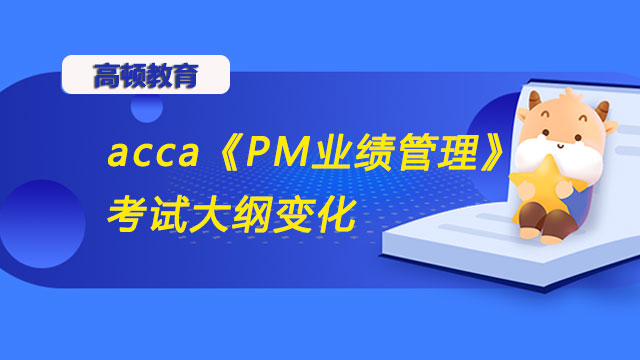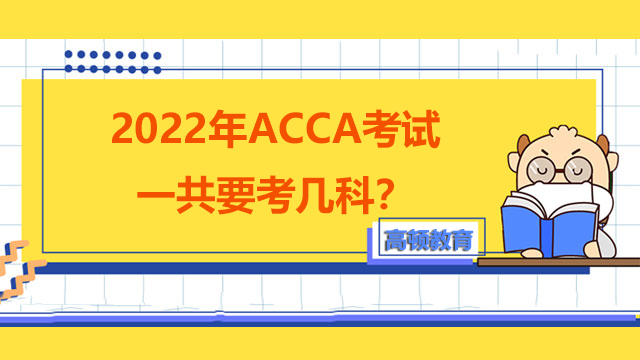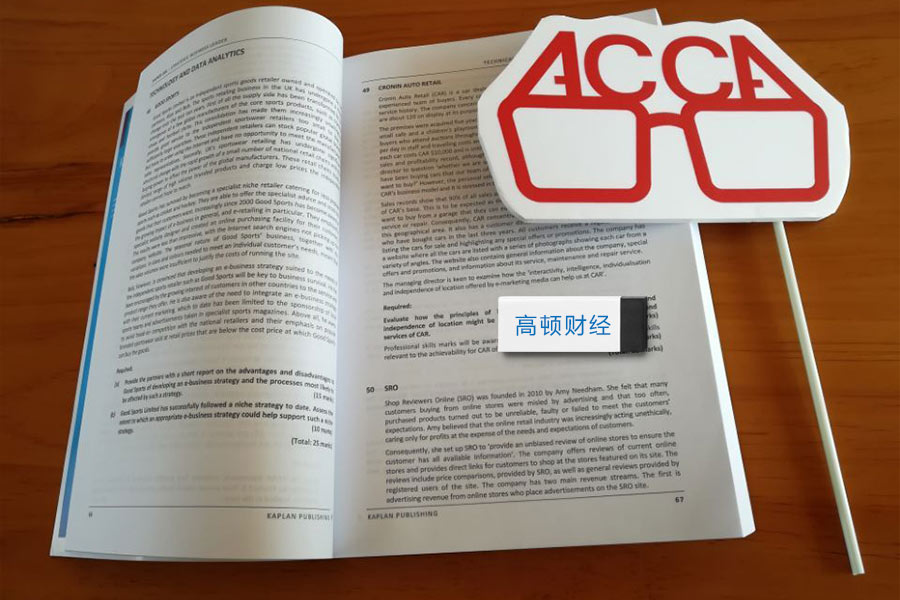2015ACCA F4 公司法和商法考试大纲
来源:
高顿网校
2015-03-25
? ACCA 2014 All rights reserved.
1
Corporate and Business
Law (ENG) (F4)
September 2014 to
August 2015
( PAPER EXAM SESSIONS IN DEC 2014 AND JUN
2015. START DATE FOR CBE NOVEMBER 19
2014.)
This syllabus and study guide is designed to help
with planning study and to provide detailed
information on what could be assessed in
any examination session.
THE STRUCTURE OF THE SYLLABUS AND
STUDY GUIDE
Relational diagram of paper with other papers
This diagram shows direct and indirect links
between this paper and other papers preceding or
following it. Some papers are directly underpinned
by other papers such as Advanced Performance
Management by Performance Management. These
links are shown as solid line arrows. Other papers
only have indirect relationships with each other
such as links existing between the accounting and
auditing papers. The links between these are shown
as dotted line arrows. This diagram indicates where
you are expected to have underpinning knowledge
and where it would be useful to review previous
learning before undertaking study.
Overall aim of the syllabus
This explains briefly the overall objective of the
paper and indicates in the broadest sense the
capabilities to be developed within the paper.
Main capabilities
This paper’s aim is broken down into several main
capabilities which divide the syllabus and study
guide into discrete sections.
Relational diagram of the main capabilities
This diagram illustrates the flows and links between
the main capabilities (sections) of the syllabus and
should be used as an aid to planning teaching and
learning in a structured way.
Syllabus rationale
This is a narrative explaining how the syllabus is
structured and how the main capabilities are linked.
The rationale also explains in further detail what the
examination intends to assess and why.
Detailed syllabus
This shows the breakdown of the main capabilities
(sections) of the syllabus into subject areas. This is
the blueprint for the detailed study guide.
Approach to examining the syllabus
This section briefly explains the structure of the
examination and how it is assessed.
Study Guide
This is the main document that students, learning
and content providers should use as the basis of
their studies, instruction and materials.
Examinations will be based on the detail of the
study guide which comprehensively identifies what
could be assessed in any examination session.
The study guide is a precise reflection and
breakdown of the syllabus. It is divided into sections
based on the main capabilities identified in the
syllabus. These sections are divided into subject
areas which relate to the sub-capabilities included
in the detailed syllabus. Subject areas are broken
down into sub-headings which describe the detailed
outcomes that could be assessed in examinations.
These outcomes are described using verbs
indicating what exams may require students to
demonstrate, and the broad intellectual level at
which these may need to be demonstrated
(*see intellectual levels below)。
INTELLECTUAL LEVELS
The syllabus is designed to progressively broaden
and deepen the knowledge, skills and professional
values demonstrated by the student on their way
through the qualification.
The specific capabilities within the detailed
syllabuses and study guides are assessed at one of
three intellectual or cognitive levels:
? ACCA 2014 All rights reserved.
2
LevelⅠ: Knowledge and comprehension
LevelⅡ: Application and analysis
LevelⅢ: Synthesis and evaluation
Very broadly, these intellectual levels relate to the
three cognitive levels at which the Knowledge
module, the Skills module and the Professional level
are assessed.
Each subject area in the detailed study guide
included in this document is given a 1, 2, or
3 superscript, denoting intellectual level, marked at
the end of each relevant line. This gives an
indication of the intellectual depth at which an area
could be assessed within the examination. However,
while level 1 broadly equates with the Knowledge
module, level 2 equates to the Skills module and
level 3 to the Professional level, some lower level
skills can continue to be assessed as the student
progresses through each module and level. This
reflects that at each stage of study there will be a
requirement to broaden, as well as deepen
capabilities. It is also possible that occasionally
some higher level capabilities may be assessed at
lower levels.
LEARNING HOURS AND EDUCATION
RECOGNITION
The ACCA qualification does not prescribe or
recommend any particular number of learning hours
for examinations because study and learning
patterns and styles vary greatly between people and
organisations. This also recognises the wide
diversity of personal, professional and educational
circumstances in which ACCA students find
themselves.
As a member of the International Federation of
Accountants, ACCA seeks to enhance the education
recognition of its qualification on both national and
international education frameworks, and with
educational authorities and partners globally. In
doing so, ACCA aims to ensure that its qualifications
are recognized and valued by governments,
regulatory authorities and employers across all
sectors. To this end, ACCA qualifications are
currently recognized on the education frameworks in
several countries. Please refer to your national
education framework regulator for further
information.
Each syllabus contains between 23 and 35 main
subject area headings depending on the nature of
the subject and how these areas have been broken
down.
GUIDE TO EXAM STRUCTURE
The structure of examinations varies within and
between modules and levels.
The Fundamentals level examinations contain
100% compulsory questions to encourage
candidates to study across the breadth of each
syllabus.
The Knowledge module is assessed by equivalent
two-hour paper based and computer based
examinations.
The Skills module examinations F5-F9 are all paper
based three-hour papers containing a mix of
objective and longer type questions. The Corporate
and Business Law (F4) paper is a two- hour
computer based objective test examination which is
also available as a paper based version from the
December 2014 examination session.
The Professional level papers are all three-hour
paper based examinations, all containing two
sections. Section A is compulsory, but there will be
some choice offered in Section B.
For all three hour examination papers, ACCA has
introduced 15 minutes reading and planning time.
This additional time is allowed at the beginning of
each three-hour examination to allow candidates to
read the questions and to begin planning their
answers before they start writing in their answer
books. This time should be used to ensure that all
the information and exam requirements are properly
read and understood.
During reading and planning time candidates may
only annotate their question paper. They may not
write anything in their answer booklets until told to
do so by the invigilator.
The Essentials module papers all have a Section A
containing a major case study question with all
requirements totalling 50 marks relating to this
case. Section B gives students a choice of two from
three 25 mark questions.
? ACCA 2014 All rights reserved.
3
Section A of both the P4 and P5 Options papers
contain one 50 mark compulsory question, and
Section B will offer a choice of two from three
questions each worth 25 marks each.
Section A of each of the P6 and P7 Options papers
contains 60 compulsory marks from two questions;
question 1 attracting 35 marks, and question 2
attracting 25 marks. Section B of both these
Options papers will offer a choice of two from three
questions, with each question attracting 20 marks.
All Professional level exams contain four
professional marks.
The pass mark for all ACCA Qualification
examination papers is 50%.
GUIDE TO EXAMINATION ASSESSMENT
ACCA reserves the right to examine anything
contained within the study guide at any examination
session. This includes knowledge, techniques,
principles, theories, and concepts as specified.
For the financial accounting, audit and assurance,
law and tax papers except where indicated
otherwise, ACCA will publish examinable
documents once a year to indicate exactly
what regulations and legislation could potentially be
assessed within identified examination sessions
For paper based examinations regulation issued or
legislation passed on or before 31st August annually,
will be examinable from 1st September of the
following year to 31st August t of the year after that.
Please refer to the examinable documents for the
paper (where relevant) for further information.
Regulation issued or legislation passed in
accordance with the above dates may be
examinable even if the effective date is in the future.
The term issued or passed relates to when
regulation or legislation has been formally approved.
The term effective relates to when regulation or
legislation must be applied to an entity transactions
and business practices.
The study guide offers more detailed guidance on
the depth and level at which the examinable
documents will be examined. The study guide
should therefore be read in conjunction with the
examinable documents list.
? ACCA 2014 All rights reserved.
4
Syllabus
AIM
To develop knowledge and skills in the
understanding of the general legal framework, and
of specific legal areas relating to business,
recognising the need to seek further specialist legal
advice where necessary.
MAIN CAPABILITIES
On successful completion of this paper candidates
should be able to:
A Identify the essential elements of the legal
system, including the main sources of law
B Recognise and apply the appropriate legal
rules relating to the law of obligations
C Explain and apply the law relating to
employment relationships
D Distinguish between alternative forms and
constitutions of business organisations
E Recognise and compare types of capital
and the financing of companies
F Describe and explain how companies are
managed, administered and regulated
G Recognise the legal implications relating to
insolvency law
H Demonstrate an understanding of corporate
and fraudulent behaviour.
RELATIONAL DIAGRAM OF MAIN CAPABILITIES
(A) Essential elements of the legal system
(B) The law of
obligations
(E)
Capital and the
financing of
companies
(H) Corporate fraudulent and criminal behaviour
(F)
Management,
administration
and regulation of
companies
(C)
Employment law C)
(D) The formation and constitution
of business organisations
(G) Insolvency law
FR (F7)
CR (P2)
CL (F4) AA (F8)
? ACCA 2014 All rights reserved.
5
RATIONALE
Corporate and Business Law is divided into eight
areas. The syllabus starts with an introduction to
the overall English legal system such as the court
system and sources of law. It then leads into the
area of the law of obligations including contract and
tort, which underpin business transactions
generally.
The syllabus then covers a range of specific legal
areas relating to various aspects of business of most
concern to finance professionals. These are the law
relating to employment and the law relating to
companies. These laws include the formation and
constitution of companies, the financing of
companies and types of capital, and the day-to-day
management, the administration and regulation of
companies and legal aspects of insolvency law.
The final section links back to all the previous areas.
This section deals with corporate fraudulent and
criminal behaviour.
DETAILED SYLLABUS
A Essential elements of the legal system
1. Law and the legal system
2. Sources of law
B The law of obligations
1. Formation of contract
2. Content of contracts
3. Breach of contract and remedies
4. The law of torts and professional negligence
C Employment law
1. Contract of employment
2. Dismissal and redundancy
D The formation and constitution of business
organisations
1. Agency law
2. Partnerships
3. Corporations and legal personality
4. The formation and constitution of a company
E Capital and the financing of companies
1. Share capital
2. Loan capital
3. Capital maintenance and dividend law
F Management, administration and the regulation
of companies
1. Company directors
2. Other company officers
3. Company meetings and resolutions
G Insolvency law
1. Insolvency and administration
H Corporate fraudulent and criminal behaviour
1. Fraudulent and criminal behaviour
? ACCA 2014 All rights reserved.
6
APPROACH TO EXAMINING THE SYLLABUS
The syllabus is assessed by a two-hour paper-based
examination.
The examination consists of:
Section A
- 25 x 2 mark objective test questions 50%
- 20 x 1 mark objective questions 20%
-
Section B
- 5 x 6 mark multi-task question 30%
100%.
All questions are compulsory.
NOTE ON CASE LAW
Candidates should support their answers on the
paper- based multi-task questions with analysis
referring to cases or examples. There is no need to
detail the facts of the case. Remember, it is the
point of law that the case establishes that is
important, although knowing the facts of cases can
be helpful as sometimes questions include scenarios
based on well-known cases. Further it is not
necessary to quote section numbers of Acts.
? ACCA 2014 All rights reserved.
7
Study Guide
A ESSENTIAL ELEMENTS OF THE LEGAL
SYSTEM
1. Law and the legal system
a) Define law and distinguish types of law.[1]
b) Explain the structure and operation of the
courts.[1]
2. Sources of law
a) Explain what is meant by case law and
precedent.[1]
b) Explain legislation and evaluate delegated
legislation.[1]
c) Illustrate the rules and presumptions used by
the courts in interpreting statutes.[1]
d) Identify the concept and impact of human
rights law.[1]
B THE LAW OF OBLIGATIONS
1. Formation of contract
a) Analyse the nature of a simple contract.[2]
b) Explain the meaning of an offer and distinguish
it from an invitation to treat.[2]
c) Explain the termination of an offer. (2)
d) Explain the meaning and consequence of
acceptance.[2]
e) Explain the need for consideration.[2]
f) Explain adequacy and sufficiency of
consideration.[2]
g) Analyse the doctrine of privity.[2]
h) Distinguish the presumptions relating to
intention to create legal relations.[2]
2. Content of contracts
a) Distinguish terms from mere representations.[1]
b) Define the various contractual terms.[1]
c) Explain the effect of exclusion clauses and
evaluate their control.[2]
3. Breach of contract and remedies
a) Explain the ways in which a contract may be
discharged. (2)
b) Explain the meaning and effect of breach of
contract.[2]
c) Explain the rules relating to the award of
damages.[2]
d) Analyse the equitable remedies for breach of
contract.[2]
4. The law of torts and professional negilgence
a) Explain the meaning of tort.[2]
b) Explain the tort of ‘passing off.’ [2]
c) Explain the tort of negligence including the
duty of care and its breach.[2]
d) Explain the meaning of causality and
remoteness of damage.[2]
e) Discuss defences to actions in negligence.[2]
f) Explain and analyse the duty of care of
accountants and auditors. (2)
C EMPLOYMENT LAW
1. Contract of employment
a) Distinguish between employees and the selfemployed.[
2]
b) Explain the nature of the contract of
employment and common law and statutory
duties placed on the employer and employee.[2]
? ACCA 2014 All rights reserved.
8
2. Dismissal and redundancy
a) Explain termination of employment by notice.[2]
b) Distinguish between summary and constructive
dismissal.[2]
c) Explain wrongful dismissal.[2]
d) Explain unfair dismissal, including the
procedure, and fair and unfair reasons for
dismissal.[2]
e) Discuss the remedies available to those who
have been subject to unfair dismissal.[2]
f) Explain what is meant by redundancy.[2]
D THE FORMATION AND CONSTITUTION OF
BUSINESS ORGANISATIONS
1. Agency law
a) Define the role of the agent and give examples
of such relationships paying particular regard
to partners and company directors.[2]
b) Explain the formation of the agency
relationship.[2]
c) Define the authority of the agent.[2]
d) Explain the potential liability of both principal
and agent.[2]
2. Partnerships
a) Demonstrate a knowledge of the legislation
governing the partnership, both unlimited and
limited.[1]
b) Discuss the formation of a partnership .[2]
c) Explain the authority of partners in relation to
partnership activity.[2]
d) Analyse the liability of various partners for
partnership debts.[2]
e) Explain the termination of a partnership, and
partners’ subsequent rights and liabilities.[2]
3. Corporations and legal personality
a) Distinguish between sole traders, partnerships
and companies.[1]
b) Explain the meaning and effect of limited
liability.[2]
c) Analyse different types of companies,
especially private and public companies.[2]
d) Illustrate the effect of separate personality and
the veil of incorporation.[2]
e) Recognise instances where separate
personality will be ignored (lifting the veil of
incorporation)。[2]
4. The formation and constitution of a company
a) Explain the role and duties of company
promoters, and the breach of those duties and
remedies available to the company.[2]
b) Explain the meaning of, and the rules relating
to, pre-incorporation contracts.[2]
c) Describe the procedure for registering
companies, both public and private.[1]
d) Describe the statutory books, records and
returns that companies must keep or make.[1]
e) Analyse the effect of a company’s
constitutional documents.[2]
f) Describe the contents of model articles of
association.[1]
g) Explain how articles of association can be
changed.[2]
h) Explain the controls over the names that
companies may or may not use.[2]
E CAPITAL AND THE FINANCING OF
COMPANIES
1. Share capital
a) Examine the different types of capital.[2]
? ACCA 2014 All rights reserved.
9
b) Illustrate the difference between various
classes of shares, including treasury shares,
and the procedure for altering class rights.[2]
c) Explain allotment of shares, and distinguish
between rights issue and bonus issue of
shares.[2]
d) Examine the effect of issuing shares at either a
discount, or at a premium.[2]
2. Loan capital
a) Define companies’ borrowing powers.[1]
b) Explain the meaning of loan capital and
debenture.[2]
c) Distinguish loan capital from share capital, and
explain the different rights held by shareholders
and debenture holders.[2]
d) Explain the concept of a company charge and
distinguish between fixed and floating
charges.[2]
e) Describe the need and the procedure for
registering company charges.[2]
3. Capital maintenance and dividend law
a) Explain the doctrine of capital maintenance
and capital reduction.[2]
b) Explain the rules governing the distribution of
dividends in both private and public
companies.[2]
F MANAGEMENT, ADMINISTRATION AND THE
REGULATION OF COMPANIES
1. Company directors
a) Explain the role of directors in the operation of
a company, and the different types of directors,
such as executive/ non-executive directors or
de jure and de facto directors .[2]
b) Discuss the ways in which directors are
appointed, can lose their office and the
disqualification of directors.[2]
c) Distinguish between the powers of the board of
directors, the managing director/chief executive
and individual directors to bind their
company.[2]
d) Explain the duties that directors owe to their
companies.[2]
2. Other company officers
a) Discuss the appointment procedure relating to,
and the duties and powers of, a company
secretary.[2]
b) Discuss the appointment procedure relating to,
and the duties and rights of a company
auditor, and their subsequent removal or
resignation.[2]
3. Company meetings and resolutions
a) Distinguish between types of meetings:
general meetings and annual general
meetings.[1]
b) Distinguish between types of resolutions:
ordinary, special, and written.[2]
c) Explain the procedure for calling and
conducting company meetings.[2]
G INSOLVENCY LAW
1. Insolvency and administration
a) Explain the meaning of and procedure involved
in voluntary liquidation, including members’
and creditors’ voluntary liquidation.[2]
b) Explain the meaning of, the grounds for, and
the procedure involved in compulsory
liquidation.[2]
c) Explain the order in which company debts will
be paid off on liquidation.[2]
d) Explain administration as a general alternative
to liquidation.[2]
e) Explain the way in which of an administrator
may be appointed, the effects of such
appointment, and the powers and duties an
administrator.[2]
? ACCA 2014 All rights reserved.
10
H CORPORATE FRAUDULENT AND CRIMINAL
BEHAVIOUR
1. Fraudulent and criminal behaviour
a) Recognise the nature and legal control over
insider dealing.[2]
b) Recognise the nature and legal control over
market abuse.[2]
c) Recognise the nature and legal control over
money laundering.[2]
d) Recognise the nature and legal control over
bribery.[2]
e) Discuss potential criminal activity in the
operation, management and liquidation of
companies.[2]
f) Recognise the nature and legal control over
fraudulent and wrongful trading.[2]
? ACCA 2014 All rights reserved.
11
SUMMARY OF CHANGES TO F4 ENG
ACCA periodically reviews its qualification syllabuses so that they fully meet the needs of stakeholders such as
employers, students, regulatory and advisory bodies and learning providers.
The main areas that have been amended in the syllabus are shown in Table 1 below:
Table 1 – Amendments to F4 ENG
Section and subject area Syllabus content
A2d) Human rights The concept and impact of human rights (Whole of A3
removed and merged into just one outcome so less
emphasis on human rights)
The main areas that have been deleted in the syllabus are shown in Table 2 below:
Table 2 – Deletions to F4 ENG
Section and subject area Syllabus content
A1b) Court structure The structure and operation of the tribunal systems
A3a) Human rights The concept of human rights as expressed in the
Human Rights Act 1998
H1a) Corporate governance The idea of corporate governance
H1b) Corporate governance The extra-legal codes of corporate governance
H1c) Corporate governance
The legal regulation of corporate governance
? ACCA 2014 All rights reserved.
高顿网校温馨提示: 通过ACCA考试实属不易,首先要有执着的精神,其次是不断勤奋的学习,高顿网校为大家提供ACCA题库免费做题,希望助大家一臂之力,查看详情》
| ACCA网络课程 | 课程专业名称 | 讲师 | 试听 |
 85%的人正在学习该课程 85%的人正在学习该课程 | ACCA 全维度网课体验课程 实景课堂与独立录制 覆盖所有知识点,根据学习计划推进学习进度 | 高顿名师 |  |
 70%的人正在学习该课程 70%的人正在学习该课程 | ACCA网课全科卡(8.2折) 为零基础刚开始学习ACCA的学员特别定制 | 高顿名师 |  |
精彩推荐:
版权声明:本条内容自发布之日起,有效期为一个月。凡本网站注明“来源高顿教育”或“来源高顿网校”或“来源高顿”的所有作品,均为本网站合法拥有版权的作品,未经本网站授权,任何媒体、网站、个人不得转载、链接、转帖或以其他方式使用。
经本网站合法授权的,应在授权范围内使用,且使用时必须注明“来源高顿教育”或“来源高顿网校”或“来源高顿”,并不得对作品中出现的“高顿”字样进行删减、替换等。违反上述声明者,本网站将依法追究其法律责任。
本网站的部分资料转载自互联网,均尽力标明作者和出处。本网站转载的目的在于传递更多信息,并不意味着赞同其观点或证实其描述,本网站不对其真实性负责。
如您认为本网站刊载作品涉及版权等问题,请与本网站联系(邮箱fawu@gaodun.com,电话:021-31587497),本网站核实确认后会尽快予以处理。
点一下领资料
【整理版】ACCA各科目历年真题
真题高频考点,刷题全靠这份资料
下载合集
acca全科学习思维导图
梳理核心考点,一图看懂全部章节
下载合集
2023年acca考纲解析
覆盖科目重难点,备考按照计划走
下载合集
acca备考 热门问题解答
- acca考试怎么搭配科目?
-
建议优先选择相关联的科目进行搭配报考,这样可以提高备考效率,减轻备考压力,1、F1-F4:为随时机考科目,难度较低,这里可以自行随意选择考试顺序。2、F5-F9:如果你的工作的和财务会计或者审计有关、或者你比较擅长财务和审计的话,推荐先考F7和F8。你可以选择一起考ACCA考试科目F7和F8或者先考F7(8)再考F8(7),这就要取决你一次想考几门。3、P阶段:选修科目中,建议企业首选AFM!第二部分科目进行选择,如果AA和SBR掌握学生更好,可以通过选择AAA,如果SBL掌握的好,可以自己选择APM。
- acca一共几门几年考完?
-
acca一共有15门考试科目,其中有必修科目和选修科目,考生需要考完13门科目才能拿下证书。
- acca一年考几次?
-
acca一年有4次考试,分别是3月、6月、9月和12月,分季机考科目是采取的这类四个考季的模式,而随时机考则是没有这方面的时间规定限制,可以随报随考。
- acca的含金量如何?
-
ACCA证书的含金量是比较高的,从就业、能力提升、全球认可等角度来说,都是比较有优势的证书,其含金量主要表现在以下几个方面:1、国际化,认可度高;2、岗位多,就业前景好;3、缺口大,人才激励。
严选名师 全流程服务
其他人还搜了
热门推荐
-
长春ACCA培训课程,高顿ACCA推荐吗? 2023-06-19
-
【考试重点】acca2023年9月SBL变化详解,速进了解! 2023-06-19
-
acca《PM业绩管理》考试大纲变化,2023年9月起变动情况一览! 2023-04-26
-
2023年6月acca考试哪些科目考纲有变化?赶快来看! 2023-04-25
-
ACCA2023年考试重点介绍,新手看过来! 2023-03-29
-
9月acca考试考纲变了吗?这些科目变动你要了解! 2023-03-10
-
acca考纲每次变化大吗?2023年9月起变动0%-12%! 2023-03-10
-
ACCA科目名称英文一览 2022-05-23
-
ACCA都考什么内容? 2022-05-20
-
ACCA课程内容介绍 2022-05-12
-
2022年ACCA考试一共要考几科? 2022-05-11
-
ACCA的考试内容都有什么? 2022-05-10
-
ACCA官网操作 | 如何鉴别自己是FIA还是ACCA&考试报名退考流程 2021-06-30
-
2020年最新ACCA考试大纲哪里找? 2020-03-04
-
2014年12月ACCA考试改动方向及难度变化,资阳考生必看! 2019-01-04
-
2014年12月ACCA考试改动方向及难度变化,资阳考生必看! 2019-01-04
-
2018年ACCA考试新旧考纲变化详解 2019-01-02
-
12月ACCA考试前瞻:2017年9月ACCA F7考试分析 2017-11-21
-
ACCA考试F8考试大纲变化解析 2017-04-19
-
ACCA考试F7考纲变化分析 2017-01-04
-
acca福建厦门考点i831在哪里 2016-12-19
-
拉萨有没有比较好的ACCA培训机构? 2016-06-29
-
石嘴山有没有比较好的ACCA培训机构? 2016-06-29
-
嘉峪关有没有比较好的ACCA培训机构? 2016-06-29
-
吐鲁番有没有比较好的ACCA培训机构? 2016-06-29
-
武夷山有没有比较好的ACCA培训机构? 2016-06-29
-
保山有没有比较好的ACCA培训机构? 2016-06-22
-
果洛有没有比较好的ACCA培训机构? 2016-06-22
-
临夏有没有比较好的ACCA培训机构? 2016-06-22
-
喀什有没有比较好的ACCA培训机构? 2016-06-22
 更多服务
更多服务





























